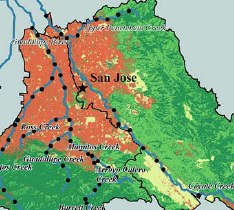OBIA for classifying urban environments for fire management
 Friday, October 31, 2008 at 9:00PM
Friday, October 31, 2008 at 9:00PM Cleve, C., M. Kelly F. Kearns and M. Moritz. 2008. Classification of urban environments for fire management support: A comparison of pixel- and object-based classifications using high-resolution aerial photography. Computers, Environment and Urban Systems 32: 317–326
We explore the accuracy of pixel-based and object-based classification methods used for mapping in the wildland–urban interface (WUI) with free, readily available, high spatial resolution urban imagery, which is available in many places to municipal and local fire management agencies. Results indicate that an object-based classification approach provides a higher accuracy than a pixel-based classification approach when distinguishing between the selected land-use and land-cover categories. Pdf download. Journal link.
Keywords: Wildland–urban interface . Classification . Image analysis . Object-based methods . Remote sensing
 fire,
fire,  obia,
obia,  remote sensing
remote sensing 
